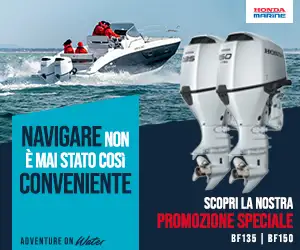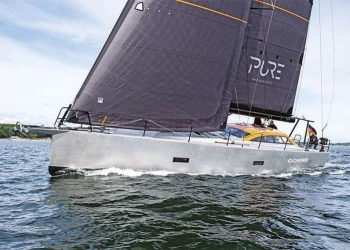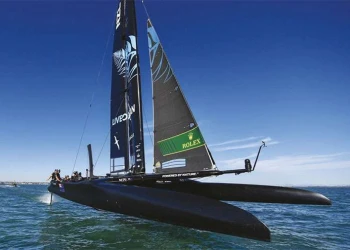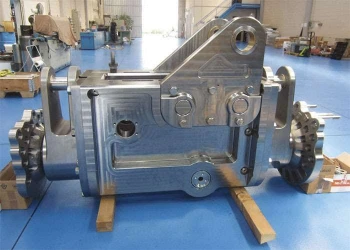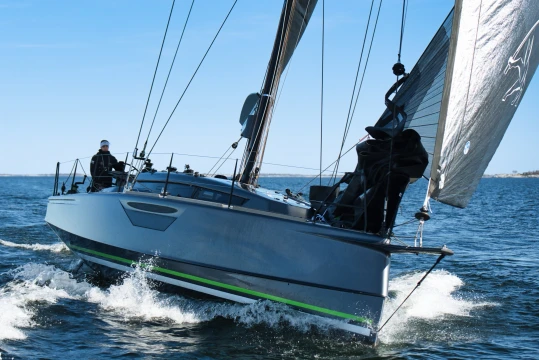
Shogun 43 is the most ambitious, ambiguous boat imaginable
Shogun 43 is the most ambitious, ambiguous boat imaginable
Forget what you thought you knew about performance cruisers, this rather aggressive-looking beast is anything but average…
In a world where nearly all new products follow a defined trend, it feels reassuring to know that someone out there has invented a boat that is like nothing else. Shogun 43 is a raised middle finger to the established mass market. And she is the most ambitious, ambiguous boat imaginable.
Have you also spent long evenings making sketches of your perfect boat? Just to see how it would look, if you could decide all for yourself? And have you also dreamed of how amazing it would be to have someone build this boat – exactly the way you wanted it? That is basically what Shogun Yachts from Sweden has done. At first, the result was a 50-footer by the name of Shogun 50, launched in 2019 and flying a bit under the radar due to the pandemic. Now a smaller sister is born. Its name is Shogun 43.
Shortly after the ice released its grip on the freezing Baltic waters northeast of Stockholm, the test sail of build no.1 took place. The crew at the yard had to wait for weeks for the ice to finally melt, everyone growing more and more anxious to try out this aggressive looking beast that took a staggering 7,000 hours to build.


The mast and rigging are carbon. Most of the sail trimming is electric or hydraulic, controlled with buttons at the wheels
The owner of Shogun, Mats Bergryd, has been fortunate to sail a lot of fine vessels through his life, a lot of it happening in the Swedish archipelago. One of the later was a 50ft performance cruiser for racing. He found the performance stunning, but the constant need to provide enough crew quickly became tiring. Also, with a 3.5- metre draught and a very ascetic interior, this was not a perfect match for the kind of sailing Bergryd was into: archipelago cruising and some racing, mostly shorthanded. At the same time he didn’t want to lose the extremely satisfying sailing experience that he had become accustomed to and really appreciated. Also, he wanted a beautiful boat. Something that would turn heads in any harbour.

If you want to build a really nice customised sailing boat, Sweden is not the worst place to start. Ever since GRP leisure boats became a thing in the late sixties, Sweden has been one of the leading nations in the industry. Today the country has a strong, established culture and know-how, and boats built in Sweden are generally considered some of the best boats in the world. Bergryd got in touch with the legendary designer Håkan Södergren, today working with his son Oscar, and asked them if they wanted to be a part of his adventure.
Södergren is famous for narrow, fast coastal cruiser/racers such as SwedeStar, Tarac 33, the Helmsman-series – and also several 5.5 Metre Rule boats. The paralympic 2.4mR is also a Södergren design. The answer was yes. Södergren, father and son, were on the team.
Next step was reaching out to Sweden’s oldest still active boatyard, Linjettvarvet, famous for the Linjett Yachts. This is a family owned, relatively small yard, especially known for their high level of craftmanship. A Linjett is considered somewhat a hybrid between boats from two other high-grade Swedish boatyards, Hallberg Rassy and Arcona. Would they want to build the Shogun yachts? Yes, they would love to do that.
Now, if the design brief of the Shogun includes sailing performance matching a racer, all packed in a shorthanded-friendly design icon with a luxury cruising interior inside, it goes without saying that it's not going to be cheap. These are extreme yachts and not easy to build, even with a big budget.

Stepping out on the dock at the Linjett Boatyard this ice-cold morning there was a feeling of intense curiosity. This was not just any boat. Could they really pull this off? Well, there she was. A grey and black panther moored between the Baltic islands, ready to attack.
Seeing a boat for the first time is always exciting. What strikes you as the first thing? The Shogun 43 is a very light boat, 6,100kg, built exclusively in vacuum-infused carbon fibre. The lines are uncompromisingly sporty, the topsides sitting low, the waterline tucked in, providing a small wet footprint. A slippery boat in light air but with ample form stability kicking in as soon as the boat starts heeling.
Shogun 43 has a reverse bow pointing even more forward than a ClubSwan and horizontal wave breakers stretching all the way along the sleek hull. The mast sits even more aft than in other contemporary high-performance boats – actually, the mast foot is behind the keel! The foretriangle is huge, which makes a selftacking jib part of an effective sailplan. There is also setup for an overlapping 106 per cent jib and a heavy weather J3 on a removable inner forestay. All spinnakers are asymmetric, furling, on a bowsprit. And of course there is a Code Zero.
Almost all production boats above, let's say eight metres, are aimed at cruising. Even this one. And without asking why, we have become accustomed to boat producers stuffing as much volume as possible into a given hull length – instead of distributing the same volume in a longer, slimmer shape. To put it bluntly this has two consequences: the boats have become uglier and their sailing performance has deteriorated.
Stepping onto the deck of the Shogun 43, it is obvious that this boat is slimmer and lower than just about any other modern boat in this size bracket. This is really a sports car, not a camper van. And it's clearly born to sail faster than just about anything else with a lead keel. The transom is designed in an extreme shape, the cockpit is huge – and yes, below deck the space probably equals a more obese 36-footer. Headroom is low, the interior design is an open plan and just about as far from mainstream as you can get. If you plan on doing long summer cruises with family, dog and friends staying over, you should definitely buy another boat. Which is probably not a big issue – most likely you can't afford this one anyway.
The sense of being in a boat smaller than its 43ft LOA vanished as soon as the sails were set and the sacred moment where the boat leans over with the pressure of the wind and starts to accelerate.
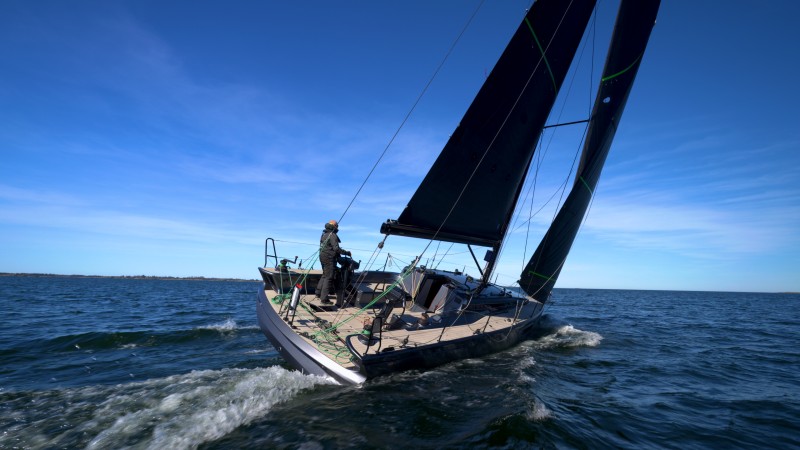
Now you feel it. Wow. In this machine all the different parts work together as a whole and create something that is really unique. There is a force in this boat that makes her behave like she’s bigger than 43ft. The stability is instantly high – she can carry the huge sail area without any problems. The light displacement transfers the pressure into fast acceleration. She’s a sporty boat for sure but she’s not a pumped-up dinghy: there is no need for the constant corrections on the helm and critical trimming of the sheets known from wide, overrigged and light boats with narrow underwater profiles. Actually the Shogun 43 sails more like a freight train on solid rails. A strong directional stability and a smooth, almost unnoticable transfer between displacement and planing modes. Double digit speeds came in short moments when gusts came between the islands and gave a bit more pressure than the eight to 10 knots she had most of the time. But it was enough to feel it: this boat can go really, really fast and she will do so in a calm and safe manner.
The Shogun 43 is a bit like a musical instrument of professional quality: It sounds good almost no matter how you play it. But in the hands of real musicians the music becomes art. The three life-long sailors on board were lucky enough to taste that potential too. In short moments the boat played totally in tune, even though she was just launched and no-one on board had had much time on the water to play with her.
The first real surprise was seeing that the mainsail outhaul was hydraulic! Actually a lot of the trimming on this boat is electric or hydraulic, controlled with buttons at the wheels. This makes it almost ridiculously easy to play around with the tuning. In most situations all you need is the helmsman’s index finger. This is a very advanced machine but much like an iPhone the user interface makes it extremely easy to work with.
Everything is set up with the best of the best, top grade stuff from Karver and Antal. The cockpit layout that accomodates a demanding race crew as well as a couple enjoying relaxed archipelago cruising. The sails (North 3Di) sit on a top-tuned carbon fibre mast with a park avenue boom. Standing rigging is carbon.
With a big Code Zero and a full main we could momentarily build enough pressure on a tight angle to push the boat close to her limits. But even then there were no signs of the rudder letting go. The boat just laid down and asked politely to be let loose again on a wider angle, so she could accelerate back to the 10 knots and was able to do it on a reach around maybe 90 degrees TWA. Wind speed and boatspeed were about the same.
Upwind, tacking in the shifting and unstable breeze between the cliffs and forests, she was doing close to eight knots – without any crew on the rail. That is actually pretty remarkable. Shorthanded racing in this boat must be a dream!
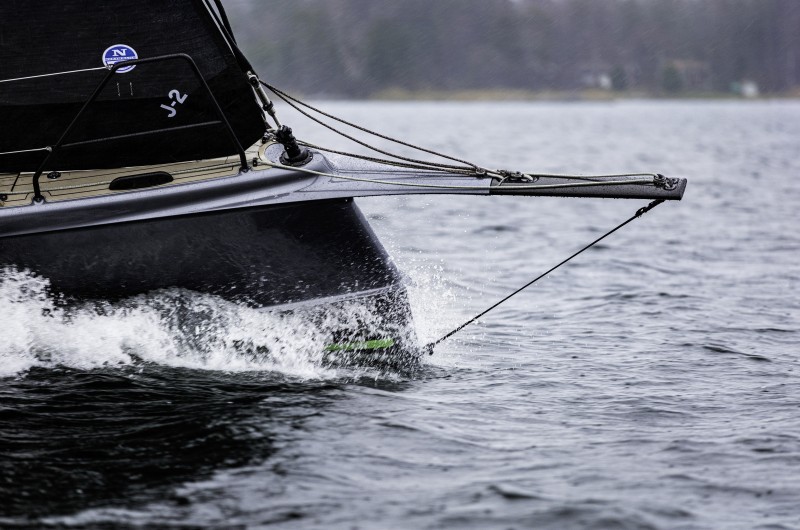
Let’s say it again: This is an extreme boat. The Shogun 43 is uncompromisingly naughty. And yet it she is a compromise, let's say between a classic Södergrendesigned Archipelago high-speed cruiser and a shamelessly radical modern, hi-tech sailing machine. Of course the price is as naughty as the rest of the boat: around a million pounds sterling, depending on your custom options.
So, even though this boat is built in Sweden, the home of social democratic equality, this is not a politically correct boat. To sail a Shogun 43 is a statement. Maybe a bit like driving a yellow Ferrari and roaring through a quiet domestic area with your hair let loose. Who doesn't secretly dream of that?
